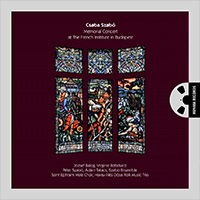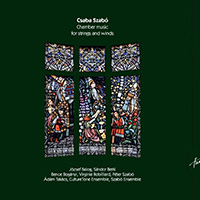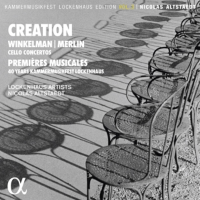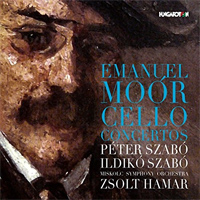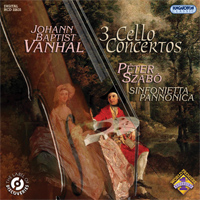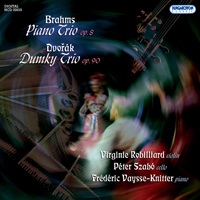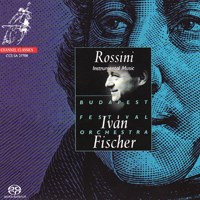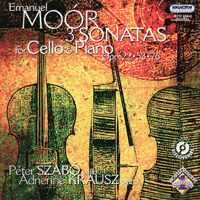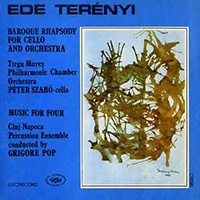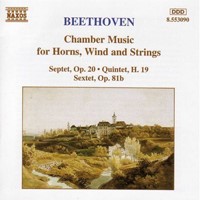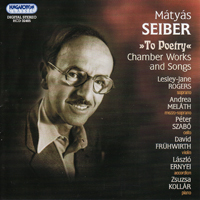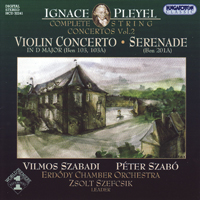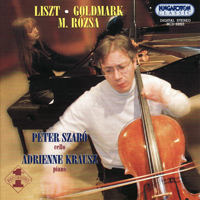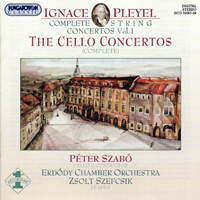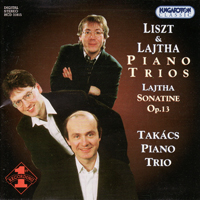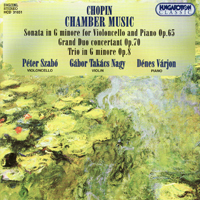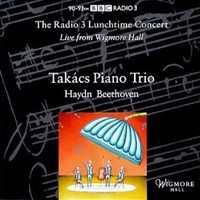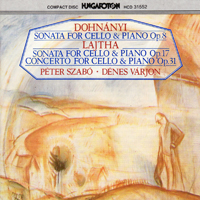Fanfare Magazine CD Review by Jerry Dubins
MOÓR Concerto in for 2 Cellos and Orchestra, op. 69. Cello Concerto in c?, op. 64. Prelude in E for Cello and Orchestra, op. 123 • Péter Szabó, 1Ildikó Szabó (vc); Zsolt Hamar, cond; Miskolc SO • HUNGAROTON 32728 (63:22)
This is truly amazing! As recently as 37:5, I found myself reviewing what I thought was a most improbable work, a full-scale Romantic concerto for two cellos, by Emanuel Moór (1865–1931). I even began that review with an expression of disbelief—“Who’d have thunk it!” I exclaimed—at such a seemingly impractical idea. Much as a novelty as it might be, Moór’s Double Cello Concerto turned out to be an arrestingly beautiful work. Indeed, everything I’ve ever heard by this relatively obscure Jewish Hungarian composer—which, admittedly, is not a lot—has absolutely convinced me that here lays buried treasure just waiting to be dug up.
It wasn’t too long ago that the name Emanuel Moór would have drawn a blank from me. Not until 2008 did the composer first come to my attention on a Cello Classics disc containing two of his cello sonatas, and I was instantly hooked, so much so that that CD ended up on my 2008 Want List. Since then, very little else by Moór has appeared on disc, save for the above-noted two-cello concerto reviewed in 37:5. Thus, it was all the more surprising when this new Hungaroton CD of the composer’s music arrived that it should contain, of all things, another recording of the same piece. Complementing it, however, is a half “normal” cello concerto by Moór, the normal half being that it’s scored for a single cello in the solo role, the not-so-normal half being that’s it’s in the rather unusual key of C ? Minor, a key which largely precludes use of three of the cello’s open strings, C, G, and D. Still, the work is a beauty, everything I hoped it would be and expected it would be based on my previous encounters with Moór’s music.
Like the two-cello concerto, the solo concerto is laid out in four movements, beginning with a Largo, in which the cellist is called upon to play some wicked-sounding, cadenza-like passages accompanied by the orchestra, but the movement soon settles into a poignant, throbbing melody, a bit reminiscent of Bruch’s Kol Nidre. But the melancholic mood doesn’t last long, as it’s overtaken by virtuosic brilliance, now somewhat reminiscent of passages in Dvořák’s B-Minor Cello Concerto. The brief scherzo-like Presto movement is abuzz with activity, while the gorgeous Adagio that follows is a touching, sorrowful, Romantic idyll, and the finale alternates a kind of brusque, military rhythmic motive with softer-contoured lyrical passages.
That Moór’s C?-Minor Concerto sounds as technically terrifying as it does—there’s lots of double-stopping at rapid tempos, for one thing—would logically lead one to believe that the composer was himself a Paganini of the cello, but he wasn’t. His main instruments were organ and piano. You could almost say that Moór—at least the little of Moór we know from his music—was a creation of Pablo Casals. The famed cellist heard some of Moór’s compositions, befriended him, encouraged him, and pronounced him a genius. The cello works by Moór that Casals would have heard predate both the solo concerto of 1906 and the two-cello concerto of 1908, and would have included three sonatas for cello and piano and the First Concerto in E Major, op. 61, all of which were premiered by celebrated cellists of the day, such as Alfred Piatti and David Popper. This is worth mentioning, because Moór was not exactly a nonentity before Casals entered the picture, but so significant a stimulus was Casals for Moór’s creativity that fistfuls of works that included a cello followed on the heels of the C ?-Minor Concerto, which was dedicated to and premiered by Casals, and a majority of those works that followed the concerto were also premiered by Casals.
It wasn’t until I dug deeper, though, into Moór’s catalog of works that I realized just how forgotten and neglected he really is. I find fewer than half a dozen CDs listed, and most of them contain a smattering of the composer’s cello pieces. Yet a complete inventory of his output, which I found at emanuel-und-henrik-moor-stiftung.de/Emanuel/works, lists 151 works with opus number, and another 69 without, a large number of which remain in manuscript form, having never been published. What’s especially shocking is that these aren’t by any definition trifling pieces; we’re talking a dozen symphonies, concertos for piano, for violin, for piano and violin, for violin, cello, and piano (premiered by Cortot, Thibaud, and Casals), for string quartet and orchestra, piano trios, piano quintets, Masses for vocal soloists, chorus, and orchestra, songs, and eight operas!
One need only listen to the two concertos on this disc to hear that Moór was a symphonist at heart. The orchestral scoring is writ large in a manner not dissimilar to Brahms and Dvořák. This is music of bold, sweeping gestures, exquisite instrumental detail, and a sure hand at managing large forms. I have a feeling that if Moór’s symphonies were to become known, he would be considered the equal of Dvořák as a composer of symphonic music. CPO, Naxos, Toccata, where are you? Moór is ripe for the picking.
In every way, this release is to be preferred over the recording of the two-cello concerto I reviewed with cellists Qin Li-Wei and Sebastian Comberti on Cello Classics in 37:5. That recording coupled the Moór with an unsatisfactory performance of the Brahms Double Concerto, featuring violinist Qian Zhou. I ended up recommending the disc, but only for the Moór, which, to the best of my knowledge, had not been previously recorded. Cellists Péter and Ildikó Szabó are far and away more techni
ally adept and culturally attuned to this music, and as important, if not more important, conductor Zsolt Hamar fully appreciates the symphonic nature of these scores and leads his Hungarian Miskolc Symphony Orchestra in vibrant, vital performances.
It goes without saying that this is seriously recommended, but seriously, too, some enterprising record company really needs to get on the ball and start committing Emanuel Moór’s works to disc, for I predict that he’s going to be the next big thing, and there’s money to be made by whoever gets there first. Jerry Dubins
This article originally appeared in Issue 38:3 (Jan/Feb 2015) of Fanfare Magazine.
Fanfare
January/February 2015
Jerry Dubins


